Aquarium Conditioned
Harlequin Tusk
Lienardella fasciata
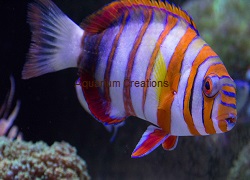 YouTube Video Feeding Harlequin Tusk
YouTube Video Feeding Harlequin Tusk
Description:
The Harlequin Tusk originates from the reefs of the Indian Ocean and Australia. Indian Ocean Tusks have orange stripes with white margins and a hint of blue adjacent to the tail of the fish. Australian Tusks have orange stripes with vivid blue margins starting from the pectoral fin, along the fishes back to their tail. Both of these beautiful color forms have bright blue teeth or tusks used to crunch invertebrates. They are a wonderful fish for a FOWLR (Fish Only With Live Rock) aquarium. These fish are typically shy when at a small size, but will in time gain personality and confidence as they mature.
Tank Recommendations:
A 125 gallon or larger aquarium with plenty of live rock is the perfect environment. Perfect for the Fish Only or FOWLR tank because though they do not harm corals, they will eat small crustacean including snails, crabs and some shrimp. Tank-mates recommended should be moderately aggressive, active fish, including Angels, Surgeon Tangs, and smaller less aggressive Triggers.
Food and diet:Feed a varied diet of chopped meaty foods such as fresh shrimp, brine shrimp, squid, clams, chopped beef heart. For the health of your fish it is always desirable to soak all fish food including algae with vitamins to help keep your fish healthier and less susceptible to disease. Try to feed at least two to three times a day In the wild they feed constantly while performing their normal cleaning activities, in the aquarium they should be fed several times a day.
Reef Compatability: Not recommended. Will not bother corals, but will eat snails and crabs. Peaceful with most fish.
Level of Care: Moderate
Approximate Purchase Size:Small 2" to 3" Medium 3" to 4-1/2" Large 4-1/2" to 6" XLarge 6" to 7" XXLarge 7" to 9"
|
Small Indonesian$149.99
Medium Indonesian$179.99
Large Indonesian$199.99
Large Australia$269.99
XLarge Australia$419.99
XXLarge Australia$569.99
|
Aquarium Conditioned
Paddlefin Wrasse
Thalassoma lucasanum
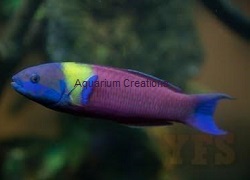 YouTube Video of Paddlefin Wrasse
YouTube Video of Paddlefin Wrasse
Description: The Paddlefin Wrasse is also referred to as the Rainbow or Cortez Rainbow Wrasse. As a juvenile they are mostly black in color with a yellow and pink belly. As they mature into an adult, their body takes on a reddish coloration, and the head area and fins become blue to green in color. The adult coloration also has a bright yellow band located just behind the head. Paddlefin Wrasses are one of the smaller wrasse within the genus growing only to about 7" maximum, and makes a wonderful addition to a fish only saltwater aquarium.
Tank Recommenations:
A 75 gallon or larger aquarium with plenty of live rock . Somewhat agressive, therefore only put in with other aggressive tank mates. The Paddlefin Wrasse becomes territorial in the aquarium therefore because of the aggressive behavior either place most of your fish in the tank at the same time, or make the Paddlefin Wrasse your last addition to the tank. One other possibility is to rearrange the entire tanks liverock so all the fish are once again finding a new home (territory). This works very well. Wrasses are known jumpers so the aquarium top should be covered.
Food and diet:
Feed a varied diet of chopped meaty foods such as fresh shrimp, brine shrimp, squid, clams, chopped beef heart. For the health of your fish it is always desirable to soak all fish food including algae with vitamins to help keep your fish healthier and less susceptible to disease. Try to feed at least two to three times a day In the wild they feed constantly while performing their normal cleaning activities, in the aquarium they should be fed several times a day.
Reef Compatability:
Won't bother corals, but this fish feeds on a wide array of invertebrates, (eats great!) including snails, sand-dwelling bivalves, hermit crabs, crabs, chitons, shrimp, isopods, amphipods and sea urchins. Not recommended for the reef aquarium.
Level of Care:
Moderate
Approximate Purchase Size:
Small 1-1/2" to 3" Medium 3" to 4" Large 4" to 6"
|
Small $49.99
Medium $59.99
Large $89.99
|
Aquarium Conditioned
Lyretail Wrasse
Thalassoma lunare
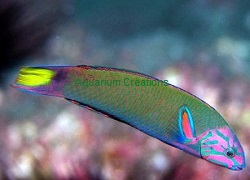
YouTube Video of Lyretail Wrasse
Description:
The Lyretail Wrasse is also referred to as the Lunare Wrasse or Moon Wrasse. As an adult, it is green with bright facial and fin markings.Bold, hardy, colorful and easy to maintain. All members of the genus Thalassoma lunare are excellent aquarium fish that can live many years in any well-maintained aquarium. They are a wonderful fish for a FOWLR (Fish Only With Live Rock) aquarium. This is an active fish that requires plenty of swimming space and tankmates that aren't too passive. The Red Sea version of the Lyretail Wrasse has the same patterns but the colors are much more distinctive and striking.
Tank Recommendations:
A 125 gallon or larger aquarium with plenty of live rock . Somewhat agressive, therefore only put in with other aggressive tank mates. The Lyretail Wrasse becomes territorial in the aquarium therefore because of the aggressive behavior either place most of your fish in the tank at the same time, or make the Lyretail Wrasse your last addition to the tank. One other possibility is to rearrange the entire tanks liverock so all the fish are once again finding a new home (territory). This works very well. Wrasses are known jumpers so the aquarium top should be covered.
Food and diet:
Feed a varied diet of chopped meaty foods such as fresh shrimp, brine shrimp, squid, clams, chopped beef heart. For the health of your fish it is always desirable to soak all fish food including algae with vitamins to help keep your fish healthier and less susceptible to disease. Try to feed at least two to three times a day In the wild they feed constantly while performing their normal cleaning activities, in the aquarium they should be fed several times a day.
Reef Compatability:
Won't bother corals, but this fish feeds on a wide array of invertebrates, (eats great!) including snails, sand-dwelling bivalves, hermit crabs, crabs, chitons, shrimp, isopods, amphipods and sea urchins. Not recommended for the reef aquarium.
Level of Care:
Moderate
Approximate Purchase Size:
Small 1-1/2" to 3" Medium 3" to 4" Large 4" to 5" XLarge 5" to 7"
|
Small $29.99
Medium $39.99
Large $69.99
XLarge $89.99
|
Aquarium Conditioned
Female Black Bird Wrasse
Gomphosus varius (female)
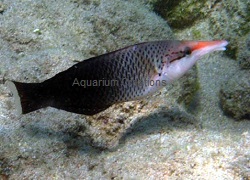
Description:
Named for their distinctive bird-like beaked snouts, and sexed by colors, Bird Wrasses are easy to identify. As juveniles, each species has their own unique transitional juvenile to adult colors and markings. G. varius males are typically medium to dark green or greenish-blue in color. Females are creamy white colored in front and dark brown to nearly black in back. G. caeruleus males are much bluer in color. Females from front to back are white to yellow on the bottom and greenish-blue on top. Both female species have bottom half white and top half peachy colored snouts.
In the wild a single male congregates with a large harem of females. Nature's way of propagating the species is that a single female will change into a male, separate from the group, and once fully transformed starts a harem of its own. For a period of time during this female to male transformation the fish possesses colors of both sexes, but eventually turns into an all green adult male.
A hardy wrasse that adapts rather well to aquarium life. Only one male should be kept to an aquarium. A male-female pair should be added to the aquarium at the same time, introducing the female first.
Recommended Tank size:
A 125 gallon or larger aquarium with plenty of live rock . Somewhat agressive, therefore only put in with other aggressive tank mates. Bird wrasses require large open swimming space and will tolerate being kept in a group providing you have one male and however many females. The male of this species is bright green and the females are brown and cream in color.
Wrasses are known jumpers so the aquarium top should be covered.
Food and Diet:
Feed a varied diet of chopped meaty foods such as fresh shrimp, brine shrimp, squid, clams, chopped beef heart. For the health of your fish it is always desirable to soak all fish food including algae with vitamins to help keep your fish healthier and less susceptible to disease. Try to feed at least two to three times a day In the wild they feed constantly while performing their normal cleaning activities, in the aquarium they should be fed several times a day.
Reef Compatability:
Won't bother corals, but this fish feeds on a wide array of invertebrates, (eats great!) including snails, sand-dwelling bivalves, hermit crabs, crabs, chitons, shrimp, isopods, amphipods and sea urchins. Not recommended for the reef aquarium.
Level of Care:
Moderate
Approximate Purchase Size:
Medium 3-1/2" to 4-1/2" Large 4-1/2" to 5-1/2" XLarge 5-1/2" to 6-1/2" XXLarge 6-1/2" to 8"
|
Medium $79.99
Large $99.99
XLarge $109.99
XXLarge $149.99
|
Aquarium Conditioned
Male Green Bird Wrasse
Gomphosus varius (Male)
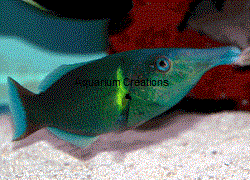
Description:
Named for their distinctive bird-like beaked snouts, and sexed by colors, Bird Wrasses are easy to identify. As juveniles, each species has their own unique transitional juvenile to adult colors and markings. G. varius males are typically medium to dark green or greenish-blue in color. Females are creamy white colored in front and dark brown to nearly black in back. G. caeruleus males are much bluer in color. Females from front to back are white to yellow on the bottom and greenish-blue on top. Both female species have bottom half white and top half peachy colored snouts.
In the wild a single male congregates with a large harem of females. Nature's way of propagating the species is that a single female will change into a male, separate from the group, and once fully transformed starts a harem of its own. For a period of time during this female to male transformation the fish possesses colors of both sexes, but eventually turns into an all green adult male.
A hardy wrasse that adapts rather well to aquarium life. Only one male should be kept to an aquarium. A male-female pair should be added to the aquarium at the same time, introducing the female first.
Recommended Tank size:
A 125 gallon or larger aquarium with plenty of live rock . Somewhat agressive, therefore only put in with other aggressive tank mates. Bird wrasses require large open swimming space and will tolerate being kept in a group providing you have one male and however many females. The male of this species is bright green and the females are brown and cream in color.
Wrasses are known jumpers so the aquarium top should be covered.
Food and Diet:
Feed a varied diet of chopped meaty foods such as fresh shrimp, brine shrimp, squid, clams, chopped beef heart. For the health of your fish it is always desirable to soak all fish food including algae with vitamins to help keep your fish healthier and less susceptible to disease. Try to feed at least two to three times a day In the wild they feed constantly while performing their normal cleaning activities, in the aquarium they should be fed several times a day.
Reef Compatability:
Won't bother corals, but this fish feeds on a wide array of invertebrates, (eats great!) including snails, sand-dwelling bivalves, hermit crabs, crabs, chitons, shrimp, isopods, amphipods and sea urchins. Not recommended for the reef aquarium.
Level of Care:
Moderate
Approximate Purchase Size:
Medium 3-1/2" to 4-1/2" Large 4-1/2" to 5-1/2" XLarge 5-1/2" to 6-1/2" XXLarge 6-1/2" to 8"
|
Medium $79.99
Large $99.99
XLarge $109.99
XXLarge $149.99
|
Aquarium Conditioned
Banana Wrasse
Thalassoma lutescens, Red Sea
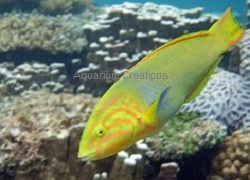 YouTube Video Red Sea Banana Wrasse
YouTube Video Red Sea Banana Wrasse
Description:
The Banana Wrasse is also known as the Sunset Wrasse, or Yellow Wrasse. The Banana Wrasse is both beautiful to look at and amazing to watch its swimming with quick maneuvers and tight turns. The female Banana Wrasse remains bright yellow color while the male turns bluish green as it matures. Both the male and female have amazing bright green stripes across their orange and pink face.
Tank Recommendations:
A 125 gallon or larger aquarium with plenty of live rock. Banana Wrasses can be kept in a predator reef aquarium, or fish only tank, with other aggressive fishes such as triggers, puffers, large tangs, angels, and other aggressive wrasses. Provide with plenty of open swimming room. If you really want a show, build several caves for it to swim through. Best added as one of the last fish introduced to the aquarium as it often becomes quite territorial and aggressive towards newly added fish. Wrasses are known jumpers so the aquarium top should be covered.
Food and Diet:
Feed a varied diet of chopped meaty foods such as fresh shrimp, brine shrimp, squid, clams, chopped beef heart. For the health of your fish it is always desirable to soak all fish food including algae with vitamins to help keep your fish healthier and less susceptible to disease. Try to feed at least two to three times a day In the wild they feed constantly while performing their normal cleaning activities, in the aquarium they should be fed several times a day.
Reef Compatability:
Won't bother corals, but this fish feeds on a wide array of invertebrates, (eats great!) including snails, sand-dwelling bivalves, hermit crabs, crabs, chitons, shrimp, isopods, amphipods and sea urchins. Not recommended for the reef aquarium.
Level of Care:
Moderate
Approximate Purchase Size:
Medium 3" to 4" Large 4" to 6" XLarge 6" to 8"
|
Medium $119.99
Large $169.99
XLarge $199.99
|

 YouTube Video Feeding Harlequin Tusk
YouTube Video Feeding Harlequin Tusk
 YouTube Video of Paddlefin Wrasse
YouTube Video of Paddlefin Wrasse



 YouTube Video Red Sea Banana Wrasse
YouTube Video Red Sea Banana Wrasse